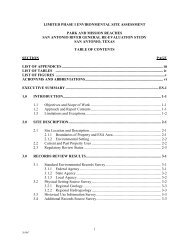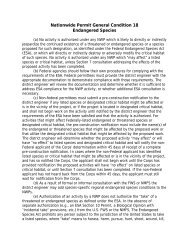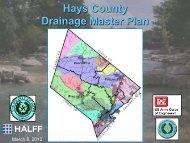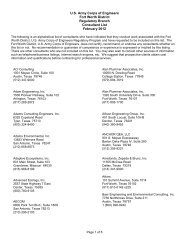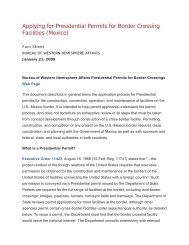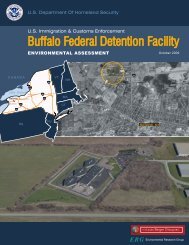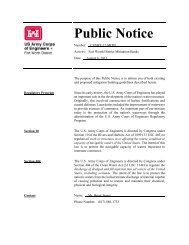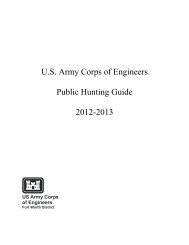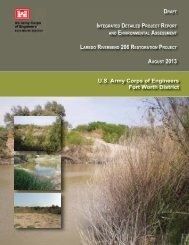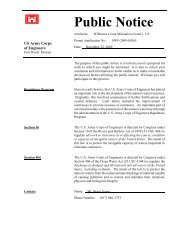environmental assessment us border patrol, tucson sector
environmental assessment us border patrol, tucson sector
environmental assessment us border patrol, tucson sector
Create successful ePaper yourself
Turn your PDF publications into a flip-book with our unique Google optimized e-Paper software.
Table 3-1, continuedDouglas FOB EA DraftAug<strong>us</strong>t 2011Common NameSouthwestern willowflycatcherScientific NameEmpidonax traillii extim<strong>us</strong>FederalStat<strong>us</strong>*Sprague's pipit Anth<strong>us</strong> spragueii CYellow-billed cuckoo Coccyz<strong>us</strong> american<strong>us</strong> CFishesEPotential to Occur Within or Immediately Adjacent to AlternativeSitesNone; dense cottonwood/willow and tamarisk (Tamarix spp.) vegetationcommunities along perennial rivers and streams.None; inhabits native grasslands with vegetation of intermediate height andlacking woody shrubs.None; inhabits areas with dense blocks of riparian woodlands, particularlycottonwood, willow, or tamarisk galleries.Beautiful shiner Cyprinella formosa T, CHNone; inhabits small- to medium-sized streams and ponds with sand,gravel, and rock bottoms. While no habitat is present within the fouralternative sites, the species does occur approximately 3 miles southwest ofthe project area on the San Bernardino NWR.Desert pupfish Cyprinodon maculari<strong>us</strong> E None; inhabits shallow springs, small streams, and marshes.Gila chub Gila intermedia E None; inhabits pools, springs, cienegas, and streams.Gila topminnowPoeciliopsis occidentalisoccidentalisELoach minnow Tiaroga cobitis TSpikedace Meda fulgida TYaqui catfish Ictalur<strong>us</strong> pricei T, CHYaqui chub Gila purpurea E, CHYaqui topminnowPoeciliopsis occidentalissonoriensisE, CHNone; inhabits small streams, springs, cienegas, and vegetated shallows.None; inhabits small to large, perennial streams with swift shallow waterover cobble and gravel. Recurrent flooding and natural hydrograph areimportant habitat characteristics.None; inhabits medium to large, perennial streams with moderate to swiftvelocity waters over cobble and gravel. Recurrent flooding and naturalhydrograph are important habitat characteristics.None; inhabits moderate to large streams with slow current movement oversand and rock bottoms. While no habitat is present within the fouralternative sites, the species does occur approximately 3 miles southwest ofthe project area on the San Bernardino NWR.None; inhabits deep pools of small streams near undercut banks and debris,pools associated with springheads, and artificial ponds. While no habitat ispresent within the four alternative sites, the species does occurapproximately 3 miles southwest of the project area on the San BernardinoNWR.None; inhabits small- to moderate-sized streams, springs, and cienegas andis generally found in shallow areas with aquatic vegetation or debris. Whileno habitat is present within the four alternative sites, the species does occurapproximately 3 miles southwest of the project area on the San BernardinoNWR.3-20



